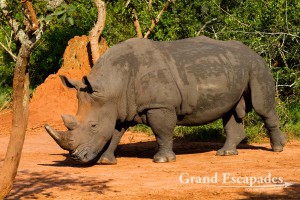
Alpha Male, Northern White Rhinoceros (Ceratotherium Simum Cottoni), Ziwa Rhino Sanctuary, North Uganda, Africa
Only a casual conversation with Johann, the South African manager of the Ziwa Rhino Sanctuary, made us aware of the true dimension of this problem. Of course, we knew that rhinos had been hunted down for their horn and brought close to extinction. But we had no clue how bad the present situation was.
British visitors to Uganda in the 1920s and 1930s described the country as being immensely rich in wild life. The years of civil war and the chaos of the Obote and Amin regimes drastically reduced the number of large mammals or brought about their extinction.
In 1960 an incredible 700 Rhinos roamed freely, in 1980 their number was down to 80 and in 1983 the very last rhino was killed. The elephant population suffered a similar fate. In that period, the number was decimated from 30.000 to less than 2.000.
Until this talk, we thought that all this was unpleasant history left behind, but poaching continues and to make matters worse on a very sophisticated level. Helicopters, state of the art equipment and a LOT of money is involved!
On the positive side, the wild life in the national parks is slowly recovering. But the Ziwa Rhino Sanctuary requires exceptional protection. The 77 hectares are surrounded by two meter high electric fence. It is solar powered and meant to keep the rhinos in and the poachers out. Of the 85 staff members, about 50 are rangers equipped with AK 47. They work in two shifts to watch each single rhino around the clock.
On display are heart-breaking photos of poached rhinos in areas less protected. Rhinos are left bleeding to death after their horns were cut from their face. Though darted with immobilizing drugs, they feel the same pain as if one of our limbs would be cut off while we are awake. There are cases were dying rhinos were found with tears running down their face.
Other traps like snare wires strangle smaller animals while they try to free themselves. Heavy irons trap an animal’s foot like that of a leopard that only recently died an agonizing death in Bugondo Forest. For three days it survived with the unbearable pain. Some ranger insisted it must have gone mad from the suffering.
In Murchison Falls a small elephant, only a few months old, was saved from the Nile by a fisherman. Its mother was shot not far away.
More information on The Rhino Fund


No comments yet.